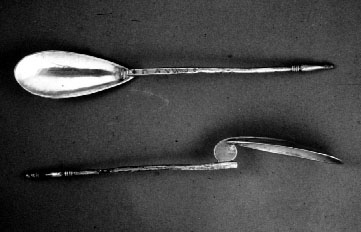The Funeral
of Scyld Scefing
[Beowulf,
lines 26-52]
| Him ða Scyld gewat
to gescæphwile
felahror feran on frean wære. Hi hyne þa ætbæron to brimes faroðe, swæse gesiþas, swa he selfa bæd, 30 þenden wordum weold wine Scyldinga; leof landfruma lange ahte. þær æt hyðe stod hringedstefna, isig ond utfus, æþelinges fær. Aledon þa leofne þeoden, 35 beaga bryttan, on bearm scipes, mærne be mæste. þær wæs madma fela of feorwegum, frætwa, gelæded; ne hyrde ic cymlicor ceol gegyrwan hildewæpnum ond heaðowædum, 40 billum ond byrnum; him on bearme læg madma mænigo, þa him mid scoldon on flodes æht feor gewitan. Nalæs hi hine læssan lacum teodan, þeodgestreonum, þon þa dydon 45 þe hine æt frumsceafte forð onsendon ænne ofer yðe umborwesende. þa gyt hie him asetton segen geldenne heah ofer heafod, leton holm beran, geafon on garsecg; him wæs geomor sefa, 50 murnende mod. Men ne cunnon secgan to soðe, selerædende, hæleð under heofenum, hwa þæm hlæste onfeng. |
Forth he fared at the
fated moment,
sturdy Scyld to the shelter of God. Then they bore him over to ocean's billow, loving clansmen, as late he charged them, 30 while wielded words the winsome Scyld, the leader beloved who long had ruled.... In the roadstead rocked a ring-dight vessel, ice-flecked, outbound, atheling's barge: there laid they down their darling lord 35 on the breast of the boat, the breaker-of-rings, by the mast the mighty one. Many a treasure fetched from far was freighted with him. No ship have I known so nobly dight with weapons of war and weeds of battle, 40 with breastplate and blade: on his bosom lay a heaped hoard that hence should go far o'er the flood with him floating away. No less these loaded the lordly gifts, thanes' huge treasure, than those had done 45 who in former time forth had sent him sole on the seas, a suckling child. High o'er his head they hoist the standard, a gold-wove banner; let billows take him, gave him to ocean. Grave were their spirits, 50 mournful their mood. No man is able to say in sooth, no son of the halls, no hero 'neath heaven, – who harbored that freight! |
Sutton Hoo
Sutton Hoo is a large cemetery that was reserved for the aristocracy of the 7th century kingdom of East Anglia. Located near what is now Suffolk, England, the cemetery was used by pagans who "made conscious reference to burial practices in Scandinavia as well as to Britain’s own prehistoric past." (Hummler). Before becoming a cemetery the site, in prehistoric and Roman times, was predominantly agricultural with the most intensive development in the neolithic or "Beaker" period (c. 2000 BC).
In 1939 a ship burial was discovered at Sutton Hoo, in a way, confirming the accuracy of the description of the burial of Scyld Scefing. The find, though it lacked a body, was undisturbed and contained a helmet, shield, sword, buckle, sceptre, lyre and various vessels, all of exceptional quality and craftsmanship. It is believed that this grave or cenotaph belonged to the East Anglian King Rædwald, who died in AD 624/5. The objects from this find are housed in the British Museum, London, and the Sutton Hoo cemetery is open to the public.
Below are artifacts discovered
at Sutton Hoo

Jewelled gold purse lid discovered at Sutton Hoo site. The detail (right) of one of the panels depicts a man between two animals, created in garnet and blue and white glass mosaic. |
||
|
Shoulder clasp for a cape |
Sceptre |
Helmet |
|
Belt Buckle –7th Century Gold and enamel 5.25" long |
Sword |
|
Bowl hook-escutcheon |
Drinking Horns |
|

Spoons inscribed 'Paul' Same spoon with side view Right slide courtesy Medieval Studies,
University of Illinois
|
||
|
Bowl (Mediterranean) |
Bowl with handles |
|
|
Pot |
||
|
Bottle |
Chalice |
|
|
Lyre This 6 stringed instrument is a copy of the 7th century Saxon Lyre found at Sutton Hoo. Amongst the worldly possessions of the Norse king was found, in a goat skin bag, the fragmented remains of a lyre, which still had with it decorative embellishments of the Saxon era. This instrument, also referred to as a battle harp, was carried in the crook of the elbow as a symbol of status. Length 28", weight 11Lbs 8ozs... |
Shield The decorative portions of the shield had been mounted on a wood and leather base which has long since rotted away. The ornaments have been pieced together on a replicated base. |
|
For more
information on the Sutton Hoo
find, visit these sites:
| The
Ancient World Web
Archaeology/Environmental Studies/Ancient History Bibliography: Sutton Hoo – 1939-1993 ORB Online Encyclopedia |
Maþelinde–
The Newsletter of Anglo-Saxon Studies at the University of Georgia. Vol.I,
number 1 (Fall, 1993)
Museum Website (Pace University) OE Art and Material Culture (bibliography) Timeline – History timeline version 1 (11/95) |
Copyright ©1998 Rachel Zirkelbach
All Rights Reserved